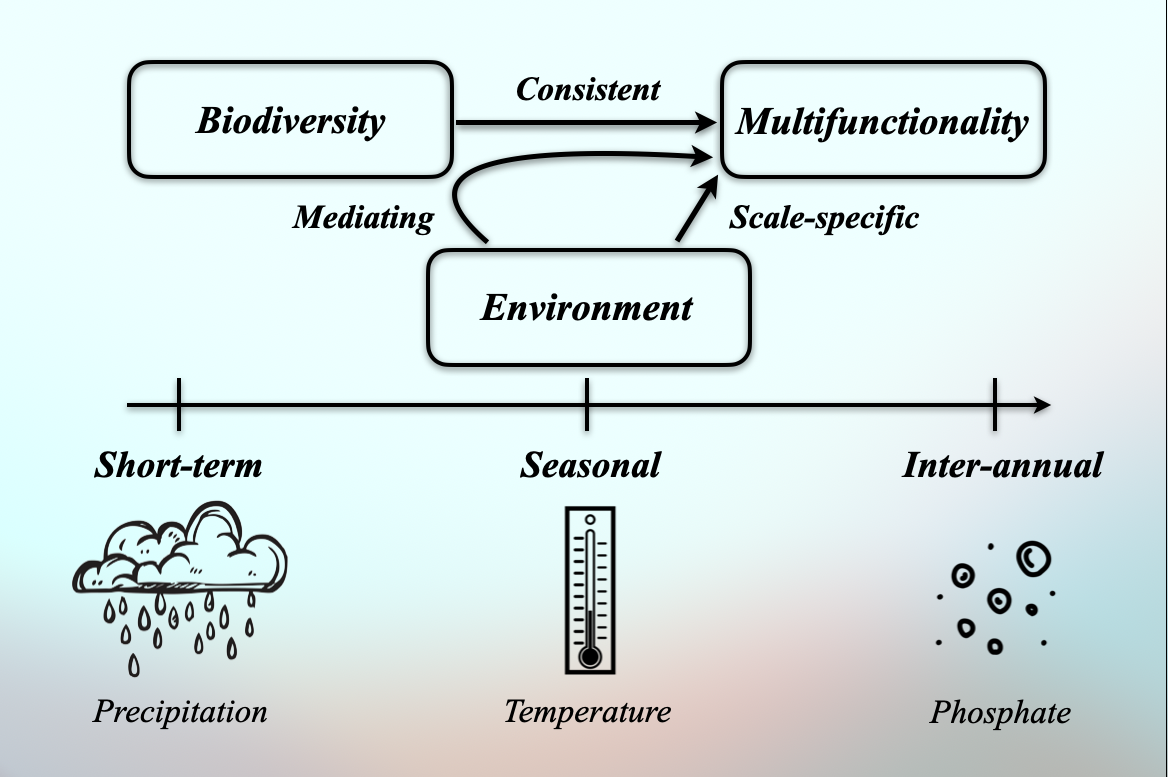Date: 2025-09-05
We live in a world full with life. The health and resilience of our ecosystems depend on their ability to perform multiple critical functions, such as mediating the nutrient cycles and toxin decomposition. However, have you ever wondered how nature keeps functioning in the face of climate change and environmental disruptions?
Historically, scientists have studied the effects of species loss in strictly controlled lab settings. While these experiments confirmed that losing species weakens these functions, the relationship in nature is far more complex. Fluctuations in environmental factors like rainfall, temperature, and nutrients not only directly impact ecosystem functions but can also cause a non-random loss of species, fundamentally changing how biodiversity supports ecosystem health.
To solve this scientific mystery, an international team—including Research Fellow Dr. Fu-Kuo Shiah from the Research Center for Environmental Changes (RCEC), Academia Sinica and TIGP-ESS alumna and postdoctoral fellow Dr. Wan-Hsuan Cheng from the Institute of Fisheries Science, at National Taiwan University—turned to nine years of high-resolution monitoring data from Taiwan's Feitsui Reservoir. This was the first study to systematically integrate 31 carbon-cycling ecosystem functions over a long period, providing a comprehensive assessment of how biodiversity regulates ecosystem multifunctionality (EMF).
The research revealed that biodiversity consistently promotes carbon decomposition-related functions across all time scales. This means that whether facing short-term events like typhoons, seasonal changes, or long-term shifts, biodiversity plays a stable and crucial role. In contrast, the effects of environmental factors like rainfall, temperature, and phosphate were confined to specific time scales, dominating short-term, seasonal, and inter-annual changes, respectively.
The most surprising finding was that biodiversity is not just a simple contributor; it acts as a central "mediator". It integrates and cushions the environmental shocks that occur at different time scales, ensuring the ecosystem maintains stable functions during dynamic changes. For example, re-oligotrophication (declining phosphate levels) can indirectly enhance long-term EMF by increasing microbial diversity, converting the potential negative effects of nutrient reduction into ecosystem functional gains.
This discovery not only deepens our understanding of how ecosystems work but also strongly reinforces a vital message: protecting biodiversity is a fundamental cornerstone for ensuring the health and resilience of our planet.
The study was published in Ecology Letters in August 2025. It was supported by Academia Sinica, the Ministry of Education, the National Science and Technology Council, National Taiwan University, Ryukoku University, and the Japan Society for the Promotion of Science.
-
 Standardized time series of (a) ecosystem multifunctionality (EMF) for 31 carbon-related functions and (e) the log of amplicon sequence variant (ASV) richness. Each time series was decomposed into seasonal, interannual, and short-term components for (b, c, d) EMF and (f, g, h) log ASV richness, respectively. Photo credit: Dr. Wan-Hsuan Cheng.
Standardized time series of (a) ecosystem multifunctionality (EMF) for 31 carbon-related functions and (e) the log of amplicon sequence variant (ASV) richness. Each time series was decomposed into seasonal, interannual, and short-term components for (b, c, d) EMF and (f, g, h) log ASV richness, respectively. Photo credit: Dr. Wan-Hsuan Cheng.
-
 Summary of the study results, showing that biodiversity consistently enhances EMF, while the effects of environmental drivers such as rainfall, temperature, and phosphate are limited to specific temporal scales. Biodiversity plays a key mediating role, integrating these diverse influences to maintain EMF across all scales, highlighting its central role in dynamic environmental conditions.Photo credit: Dr. Wan-Hsuan Cheng.
Summary of the study results, showing that biodiversity consistently enhances EMF, while the effects of environmental drivers such as rainfall, temperature, and phosphate are limited to specific temporal scales. Biodiversity plays a key mediating role, integrating these diverse influences to maintain EMF across all scales, highlighting its central role in dynamic environmental conditions.Photo credit: Dr. Wan-Hsuan Cheng.









 Home
Home
